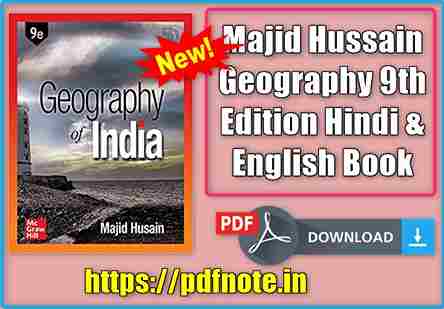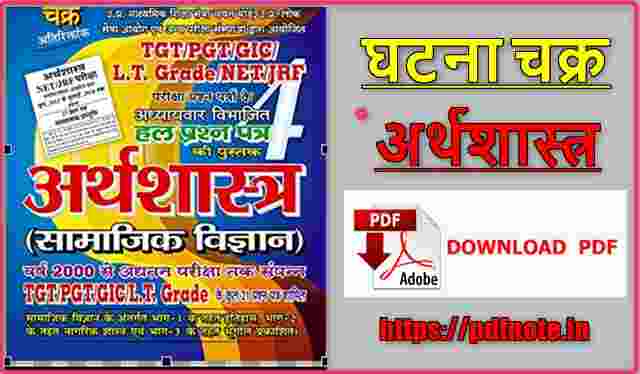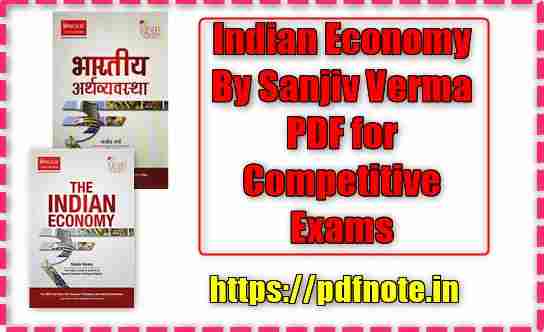Majid Hussain Geography 9th Edition Hindi & English Book PDF Download:- Dear Students आज फिर से आपलोग के Pdfnote पर स्वागत हैं जैसे की आपलोग को पता ही होगा की माजिद हुसैन के 9th Edition आ चूका हैं, तो आपलोग geography of india majid husain 9th edition के जरुर ढूंड रहे होंगे तो विधार्थी चिंता के कोई बात नहीं हैं आपलोग एकदम बिलकुल सही पेज चुने आपलोगों के इस लेख के माध्यम Majid Hussain Geography 9th Edition Hindi & English Book PDF साँझा कर रहे हैं, जिसे आपलोग निचे दिए गए डाउनलोड बटन पर क्लिक कर के Majid Hussain Geography Book for UPSC Download कर सके हैं |
भारत का भूगोल उन सभी उमीदवारो के लिए लिखी जो की UPSC, SSC तथा Civil Services and Other State Examinations तैयारी कर रहे हैं majid hussain geography book in hindi अपने 9th Edition में प्रवेश कर चूका हैं यह पुस्तक एक स्थापित मैनुअल और सेगमेंट में बेस्टसेलर है। यह majid hussain geography book in hindi व्यापक रूप से पढ़ी जाने वाली संदर्भ पुस्तक है, जो व्यवस्थित और व्यापक तरीके से भारत के भौगोलिक परिदृश्य के प्रासंगिक विषयों से संबंधित है।
Important Notes:-
- Indian and World Geography PDF Majid Husain latest Edition
- Pratiyogita Darpan Current Affairs February 2022 PDF Download
- Uttarakhand Police Constable Previous Year Question Paper PDF
- Indian Polity Notes 6th Edition PDF Free Download in Hindi
Majid Hussain Geography 9th Edition Hindi & English Book PDF

Majid Hussain Geography Book in Hindi Content:-
1. Geological Structure and formation of India Structure of India
- 1.1-1.20 Introduction
- 1 The Archaean Formations (Pre-Cambrian)
- 3 Dharwar System (Proterozoic Formations)
- 6 The Cuddapah System (The Purana Group)
- 8 The Vindhyan System 9 The Palaeozoic Group (Cambrian to Carboniferous Period)
- 10 The Mesozoic Era (The Gondwana System)
- 10 The Cretaceous System (The Deccan Trap)
- 12 The Tertiary System (The Cenozoic Era)
- 13 The Quaternary Period (The Pleistocene and Recent Formations)
- 15 Geodiversity and Geotourism
- 16 Fossil Parks
- 17 References
1.20 2. Physiography
- 2.1-2.49 Physiographic Divisions of India
- 2.1 The HIMALAYAN region
- 2.1 The Importance of the Himalayas
- 2.20 The Great Plains of India
- 2.21 Importance of the Great Plains of India
- 2.30 The Indian Desert
- 2.30 Origin and Physiography of Peninsular India
- 2.32 The Coastal Plains
- 2.41 The Indian Islands
- 2.42 Vulcanicity
- 2.48 References
2.48 3. The Drainage System of India
- 3.1-3.60 The Drainage System
- 3.1 Drainage Patterns
- 3.2 River Basins of India
- 3.6 The Multiple River Theory
- 3.11 River Systems of the Himalayan Drainage
- 3.11 Main Rivers of Peninsular India
- 3.24 Easterly Rivers of the Peninsular Region
- 3.25 Shifting Courses of the Rivers
- 3.30 Saraswati-The Mystery of A Lost River
- 3.31 Types of Lakes
- 3.35 Main Lakes of India
- 3.36 The Inter-State Water Disputes
- 3.47 International Agreements for Surface Water Resources
- 3.49 National Water Grid
- 3.51 Ground Water Resources of India
- 3.54 The National Water Policy 2012
- 3.56 Main Waterfalls of India
- 3.57 References
3.59 4. Climate of India
- 4.1-4.57 Introduction
- 4.1 Indian Monsoon
- 4.1 Indian Monsoons and the Tibet Plateau
- 4.6 Jet Stream and Indian Monsoon
- 4.8 El-Nino and the Indian Monsoon
- 4.10 Burst of Monsoon
- 4.15 Breaks in the Monsoon
- 4.16 Seasons in India
- 4.19 Tropical Cyclones
- 4.29 Thunderstorms
- 4.31 Rainfall Distribution
- 4.33 Variability of Rainfall
- 4.34 Climatic Regions of India
- 4.35 Koppen’s Classification of Indian Climate
- 4.35 Climatic Divisions by Stamp and Kendrew
- 4.38 Trewartha’s Classification of Indian Climate
- 4.41 Climatic Divisions of India by R.L. Singh (1971)
- 4.43 Droughts
- 4.45 Floods
- 4.49 References
4.56 5. Natural Vegetation and National Parks
- 5.1-5.37 Introduction
- 5.1 Floristic Regions of India
- 5.2 Spatial Distribution of Forests in India
- 5.4 Classification of Forests
- 5.8 Important Species of Trees and Their Utility
- 5.13 Forest Products and their Utility
- 5.16 Problems of Indian Forestry
- 5.18 The National Forest Policy
- 5.20 Social Forestry
- 5.21 Existing Position of Forest Ecosystems
- 5.23 Forest Conservation
- 5.24 WildLife
- 5.25 Biosphere Reserves
- 5.29 Mangroves
- 5.32 References
6. Soils
- 6.1-6.23 Introduction
- 6.1 Controllers of Soil Characteristics
- 6.2 Classification of Soils of India
- 6.5 Problems of Indian Soils
- 6.11 Consequences of Soil Erosion
- 6.18 Soil Conservation
- 6.19 References
6.23 7. Resources
- 7.1-7.35 Natural Resources
- 7.1 Mineral Resources
- 7.2 Biotic Resources
- 7.29 References
7.35 8. Energy Resources
- 8.1-8.35 Sources of Conventional Energy
- 8.1 Coal Deposits of the Tertiary Period
- 8.8 Import 8.15 Non-Conventional Energy
- 8.31 Energy Crisis
- 8.34 Energy Conservation
- 8.34 References
8.34 9. Agriculture
- 9.1-9.78 Land Utilisation
- 9.2 Characteristics and Problems of Indian Agriculture
- 9.7 Determinants of Agriculture
- 9.13 Land Reforms
- 9.17 Infrastructure and Agricultural Inputs
- 9.23 Second Green Revolution
- 9.53 White Revolution
- 9.54 Blue Revolution
- 9.58 Aquaculture
- 9.62 Apiculture (Beekeeping) or Golden Revolution
- 9.63 Sericulture
- 9.66 Poultry Farming (Silver Revolution)
- 9.67 Horticulture
- 9.69 Dry Farming
- 9.71 Agribusiness
- 9.74 National Commission on Farmers
- 9.75 Indian Agriculture—Challenges and Prospects
- 9.76 References
9.77 10. Spatial Organisation of Agriculture
- 10.1-10.30 Cropping Patterns
- 10.1 Crop Concentration
- 10.4 Agricultural Productivity
- 10.6 Agricultural Intensity
- 10.9 Crop Combinations
- 10.10 Land Capability
- 10.14 Contract Farming
- 10.15 Agricultural Regionalisation
- 10.15 Agro-Climatic Regions of India
- 10.21 Agro-Ecological Regions of India
- 10.27 References
10.30 11. Industries
- 11.1-11.75 Evolution of Industries
- 11.1 Industrial Development During the Five-Year Plans
- 11.2 Industrial Policy
- 11.4 Cotton Textile Industry
- 11.6 Jute Textile
- 11.13 Woollen Textiles
- 11.16 Silk Textile
- 11.18 Iron and Steel Industry
- 11.20 Problems of the Iron and Steel Industry
- 11.26 Automobile Industry
- 11.30 Fertiliser Industry
- 11.33 Paper Industry
- 11.37 Pharmaceutical Industry
- 11.40 Cottage Industries
- 11.43 Industrial regions of India
- 11.44 Multinational Corporations
- 11.50 Liberalisation
- 11.52 Industrial Problems of India
- 11.54 Special Economic Zone (SEZ)
- 11.55 Public Sector Undertaking
- 11.57 Tourism
- 11.58 Tourism in India
- 11.59 Eco-Tourism
- 11.64 Community Eco-Tourism Initiative
- 11.66 The Native and Psycho-Social Impact of Eco-tourism
- 11.67 Industrial Houses in India
- 11.69 Industrial Complexes
- 11.73 References
11.75 12. Transport, Communications and Trade
- 12.1-12.48 Transport
- 12.1 Water Transport
- 12.15 Air Transport
- 12.24 Pipelines Transportation
- 12.28 Metro Rail System
- 12.31 Communications
- 12.34 International Trade
- 12.37 Salient Features of Foreign Trade
- 12.40 Balance of Trade and Balance of Payment
- 12.41 Trade Policy
- 12.43 India—Space Programme
- 12.44 References
12.48 13. Cultural Setting
- 13.1-13.90 Origin of Mankind
- 13.1 The Caste System
- 13.3 Racial and Ethnic Diversity in India
- 13.5 Religious Minorities
- 13.11 Scheduled Tribes
- 13.11 Scheduled Castes (16.60% of The Total Population)
- 13.26 Cultural Regions
- 13.27 Demographic Characteristics of Indian Population
- 13.44 Literacy Rate 13.64 Age Composition
- 13.70 Migration
- 13.71 Population Problems
- 13.80 Health Indicators
- 13.84 Human Development Index in India
- 13.85 References
13.89 14. Settlements
- 14.1-14.61 Introduction
- 14.1 Classification of Settlements
- 14.2 City Region and Planning
- 14.46 Slums and Associated Problems
- 14.48 Problems of Urbanisation
- 14.53 Town Planning in India
- 14.56 Principles of Urban Planning
- 14.56 References
14.60.15. Regional Development and Planning
- 15.1-15.59 Planning in India
- 15.1 Five-Year Plans
- 15.3 Regional Dimensions of Planning in India
- 15.8 Integrated Area Development
- 15.11 Integrated Rural Development Programme (IRDP)
- 15.12 Development of Backward Areas
- 15.13 Command Area Development
- 15.15 Watershed Management
- 15.16 Area Development Programmes
- 15.19 National Watershed Development Project for Rainfed Areas (NWDPRA)
- 15.32 Rainfed Area Development Programme (RADP)
- 15.32 Multi-Level Planning
- 15.33 The Damodar Valley Corporation
- 15.37 The National Capital Region (National Capital Region)
- 15.41 Poverty in India
- 15.49 Geography and Regional Planning
- 15.52 Regional Planning and Development of Island Territories
- 15.55 References
15.58 16. India–Political Aspects
- 16.1-16.56 Political Geography
- 16.1 Structure of the Indian Federation
- 16.7 Regional Consciousness and National Integration
- 16.12 National Integration in India
- 16.14 Nationalism
- 16.15 International Boundaries of India
- 16.17 Cross Border Terrorism
- 16.31 India’s Role in World Affairs
- 16.35 Geopolitics of South Asia
- 16.36 India and the Geo-Politics of the Indian Ocean
16.38 17. Contemporary Issues
- 17.1-17.60 Environmental Hazards
- 17.1 Natural Disasters
- 17.1 Environmental Pollution
- 17.24 Environmental Awareness
- 17.26 Changes in Patterns of Land Use
- 17.28 Environmental Impact Assessment (EIA)
- 17.29 Environmental Management
- 17.29 Population Explosion and Food Security
- 17.30 Urban Disasters 17.33 Environmental Degradation
- 17.34 Problems of Agrarian Unrest 17.37 Industrial Unrest
- 17.40 Regional Disparities in Economic Development
- 17.41 Relationship between Population and Development
- 17.46 Globalisation and the Indian Economy
- 17.51 Agriculture and Globalisation
- 17.54 References
- 17.58 Multiple Choice Questions M.1-M.26
majid hussain geography book in hindi मुख्य विशेषताएं:-
- जम्मू और कश्मीर और लद्दाख के नए नामित केंद्र शासित प्रदेश के लिए भारत की प्रशासनिक सीमा में नवीनतम संशोधनों के साथ पूरी तरह से संशोधित पुस्तक।
- वर्तमान पर आधारित यूपीएससी पाठ्यक्रम, सैद्धांतिक अवधारणाओं में मजबूत, अतिरिक्त मूल मानचित्रों और आरेखों के साथ पूरक।
- अद्यतन डेटा और सांख्यिकी।
- शहरी आपदाओं, साइबर अपराध और सोशल मीडिया जैसे विषयों के साथ समसामयिक मामलों पर संशोधित अध्याय।
- नीति आयोग, एकीकृत वाटरशेड विकास पर पूरी तरह से संशोधित सामग्री कार्यक्रम, सरकारी योजनाएं और पहल, राष्ट्रीय नई खनिज नीति 2019.
- भारत में क्षेत्रीय विकास और योजना, कृषि, खनिज और संसाधन, परिवहन और संचार प्रणालियों पर पूरी तरह से संशोधित अध्याय।
- माइंड मैप, फ्लोचार्ट, सारणीबद्ध प्रारूप और सांख्यिकीय के रूप में प्रस्तुत सामग्री बेहतर समझ के लिए तकनीक।
Geography of India Majid Husain Latest Edition सामान्य प्रश्न:-
Q.1 क्या माजिद हुसैन का भारतीय भूगोल UPSC के लिए अच्छा है?
Ans – माजिद हुसैन द्वारा भारत का भूगोल। माजिद हुसैन की पुस्तक Geography of India Majid Husain Latest Edition” इस विषय पर एक व्यापक पुस्तक है जो विभिन्न प्रतियोगी परीक्षाओं की तैयारी करने वाले छात्रों के बीच बहुत लोकप्रिय है। पुस्तक में भारतीय भूगोल के लगभग सभी विषयों को शामिल किया गया है।
Majid Hussain Geography 9th Edition Hindi & English Book PDF Download
| Geography of India Majid Husain 9th Edition Hindi Book | BUY NOW |
| Majid Hussain Geography 9th Edition English Book | BUY NOW |
Related Notes:-
- Indian Polity Notes by M. Laxmikant Pdf 6th Edition Download
- Indian Economy by Ramesh Singh PDF 13th Edition Hindi & English
- India World Geography GK PDF in Hindi Pariksha Manthan
Facebook Page से जुड़ने के लिए Follow करे — Click Here
Telegram से जुड़ने के लिए Follow करे — Click Here

